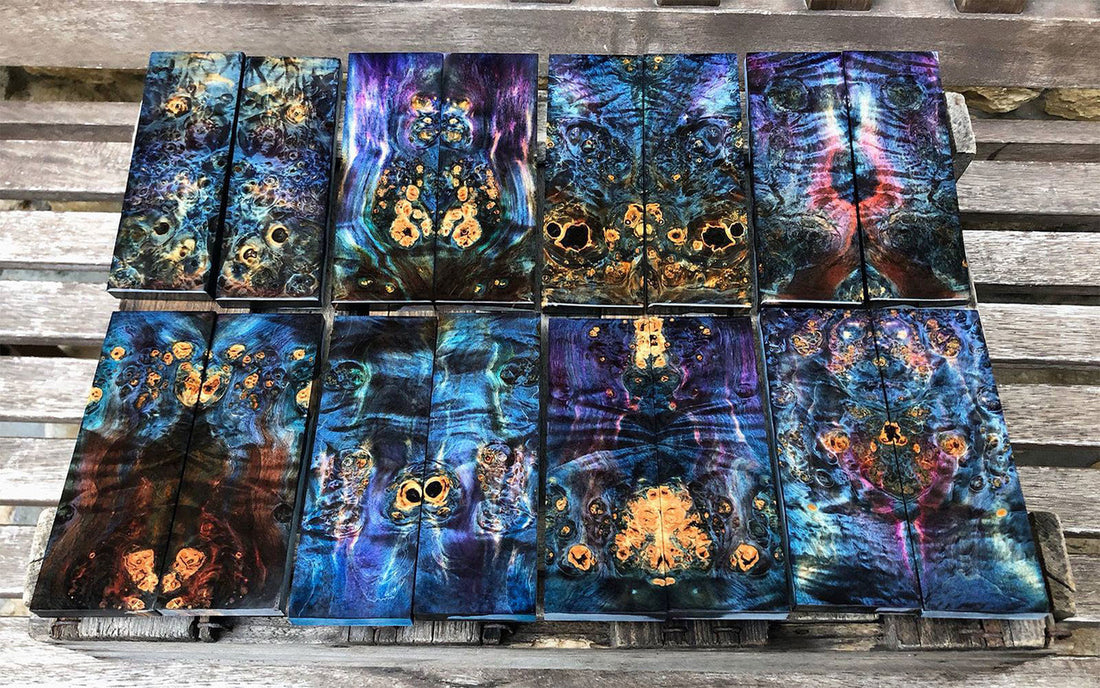We are often asked whether this or that wood is suitable for stabilization. A blanket answer is actually not possible, as many factors come into play. There are, of course, wood types such as spalted beech or buckeye burl that never pose problems due to their open-pored structure and density, but even here, excessive residual moisture can negatively affect the result.
But let's start from the beginning. Woods with high density, such as desert ironwood or rosewood, are unsuitable for stabilization because the stabilization resin simply cannot penetrate the wood. Oily woods like thuya burl or olive wood, regardless of their density, also take in insufficient resin. Wood components can thus prevent or adversely affect stabilization. Residual moisture plays an important role in all woods that one intends to stabilize.
Whenever possible, we let our sawn woods dry in the open air for at least two to three years. Kiln-dried woods can be processed more quickly, but depending on the drying method, the wood structure may change, sometimes negatively and sometimes even positively affecting the stabilization result. Testing is the only way to find out.
Most dry wood has a residual moisture content of 10 - 15%. For an optimal stabilization result, the residual moisture should be below 7%, which means further drying is necessary. The easiest method is drying on a running radiator, but the risk of cracking is very high.
Alternatively, you can use a laboratory oven, which you'll need anyway for tempering the resin-soaked woods. Microwave drying is also possible, but there is a high risk of fire, so it's best to avoid it.Important: All post-dried woods must cool down again.Regarding the structure, open pores are crucial for stabilization.
The only exception, unfortunately, is redwood burl, also known as sequoia or vavona burl. It's best to forget about working with this wood. When dealing with new woods, I perform a kind of "blow test," where I place the edge of a wood block against my lips and try to blow air into the wood with pressure. If it goes in easily, the wood is very porous, and one can expect a good result.
However, wood is anything but homogeneous. Even within a single log, there are areas that differ significantly. This is particularly evident in the case of the color-stabilized burl of European maple.
See the following illustration:
But let's start from the beginning. Woods with high density, such as desert ironwood or rosewood, are unsuitable for stabilization because the stabilization resin simply cannot penetrate the wood. Oily woods like thuya burl or olive wood, regardless of their density, also take in insufficient resin. Wood components can thus prevent or adversely affect stabilization. Residual moisture plays an important role in all woods that one intends to stabilize.
Whenever possible, we let our sawn woods dry in the open air for at least two to three years. Kiln-dried woods can be processed more quickly, but depending on the drying method, the wood structure may change, sometimes negatively and sometimes even positively affecting the stabilization result. Testing is the only way to find out.
Most dry wood has a residual moisture content of 10 - 15%. For an optimal stabilization result, the residual moisture should be below 7%, which means further drying is necessary. The easiest method is drying on a running radiator, but the risk of cracking is very high.
Alternatively, you can use a laboratory oven, which you'll need anyway for tempering the resin-soaked woods. Microwave drying is also possible, but there is a high risk of fire, so it's best to avoid it.Important: All post-dried woods must cool down again.Regarding the structure, open pores are crucial for stabilization.
The only exception, unfortunately, is redwood burl, also known as sequoia or vavona burl. It's best to forget about working with this wood. When dealing with new woods, I perform a kind of "blow test," where I place the edge of a wood block against my lips and try to blow air into the wood with pressure. If it goes in easily, the wood is very porous, and one can expect a good result.
However, wood is anything but homogeneous. Even within a single log, there are areas that differ significantly. This is particularly evident in the case of the color-stabilized burl of European maple.
See the following illustration:

Intact, bright-looking branch knots take in no resin at all, whereas the surrounding areas can take in a lot of resin and appear correspondingly colored. These different structures are not a drawback; rather, with increasing experience, they allow one to bring out subtleties in the wood that would not be visible without stabilization.
In conclusion, I can only say that one should consider stabilization as a kind of journey of discovery. There will be wood types that you'll avoid in the future. Others you'll come to love and try to bring out the best in them.
A.M.


